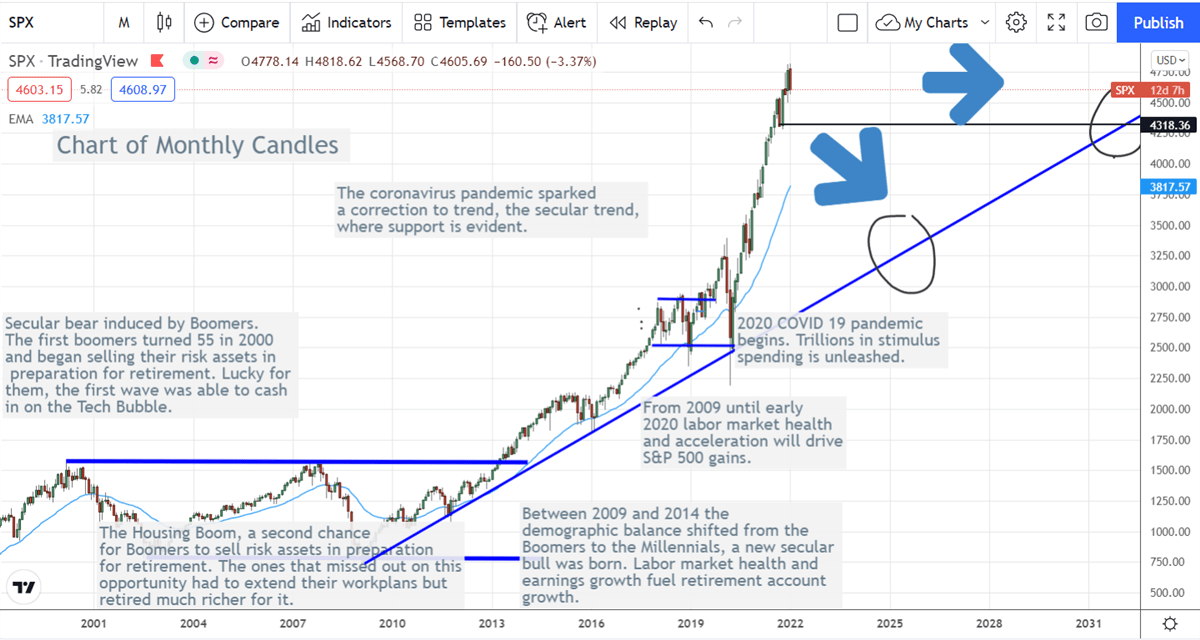What Goes Up, Must Come Down, Eventually
If you are worried about an impending correction you have good reason to be. There are a number of factors weighing on the broad market S&P 500 NYSEARCA: SPY that could easily cause a 10%, 20%, or 30% correction in prices. While we could go on and on with our preamble, we are going to get right to the point because the evidence speaks for itself.
1) Inflation - Inflation is running out of control. You can waste time arguing about who, why, what, and when but the salient point is that inflation is running at a high single-digit rate, well above the FOMC’s 2% target, and it appears to be accelerating. The scary thing about this is that we’re very close to a full year of high-single-digit inflation. Come April, if something hasn’t changed, we’ll be on a double-digit two-year stack when it comes to pricing and that is not a good thing.
2) The FOMC - It is the FOMC’s job to control inflation and so far what we’ve seen is a Fed that first underestimated the amount and duration of inflation spikes, then compounded that mistake by sticking to its guns, then compounded the mistake again with a “wait and see” attitude, and now the committee is so far behind the curve the market and inflation is telling them what to do. In our view, raising rates now is only going to spur inflation again because systemic demand and backlogs are so high. Bottom line? There is business that needs to get done, if the Fed makes it more expensive to do business it’s going to cut into profits and demand.
3) The Ten-Year Treasury - The Ten-Year Treasury INDEXCBOE: TNX is moving higher in response to the Fed’s taper, the outlook for higher rates, and the plan to run off the balance sheet. The Fed says it will begin the run-off within months of the first rate hike and the first rate hike is expected in March with a 91% probability. What this means is the FOMC will have gone from unbelievably dovish to very hawkish in less than a year and with most of that change within a 6-month time span. Looking at the chart of the TNX, we can expect to see interest rates for government debt to move up to the 2.5% range by the end of the year. That means it’s going to be more expensive for the government to operate and for U.S. corporations to finance their operations and buy back stock. That’s why the tech sector is getting hit so hard lately.
4) COVID-Spending - The government unleashed trillions of dollars in COVID-related spending and that money fueled the economy over the last 2 years. The bad news is that that money is all but spent, the tailwinds driven by it are largely gone, and now the economy will have to get by on its own. The economy is in good shape, ultimately, but spending without all those deficit-related dollars will have far less impact and demand appears to be waning, at least in some areas.
5) Retail Sales - Retail sales have been flagging for the last few months at least. While the figures have come in largely as expected a 2% or 3% increase in sales does not make up for the fact prices are up 7% from last year. In that light, theh volume of retail sales has been negative for months with the difference made up by pricing. The latest figures, however, came in negative showing demand has fallen below the threshold at which pricing increases can offset the loss.
6) The Biden Agenda - At the risk of getting political, the Biden Agenda is having an understated impact on the market. The president has so far been unable to unite even his own party in the push to pass his trillions in social spending and it doesn’t look like it will ever happen. That’s a boost to economic activity that got priced in to some degree over the last year and now it needs to get priced out.
7) The Technical Picture - To really get a feel for how inflated the economy is right now you need to look at the S&P 500 chart of monthly prices. The S&P 500 rocketed up off the COVID bottom on stimulus, easy money policy, and the hopes of additional stimulus (not even related to the Biden Agenda) that never came to pass. Now, the index is so far above trend, about 72%, that it will take years of selling for the market to 1) correct back to trend or 2) consolidate sideways until the trend catches up.

Before you consider SPDR S&P 500 ETF Trust, you'll want to hear this.
MarketBeat keeps track of Wall Street's top-rated and best performing research analysts and the stocks they recommend to their clients on a daily basis. MarketBeat has identified the five stocks that top analysts are quietly whispering to their clients to buy now before the broader market catches on... and SPDR S&P 500 ETF Trust wasn't on the list.
While SPDR S&P 500 ETF Trust currently has a Hold rating among analysts, top-rated analysts believe these five stocks are better buys.
View The Five Stocks Here
Wondering when you'll finally be able to invest in SpaceX, Starlink, or X.AI? Enter your email address to learn when Elon Musk will let these companies finally IPO.
Get This Free Report
Like this article? Share it with a colleague.
Link copied to clipboard.
